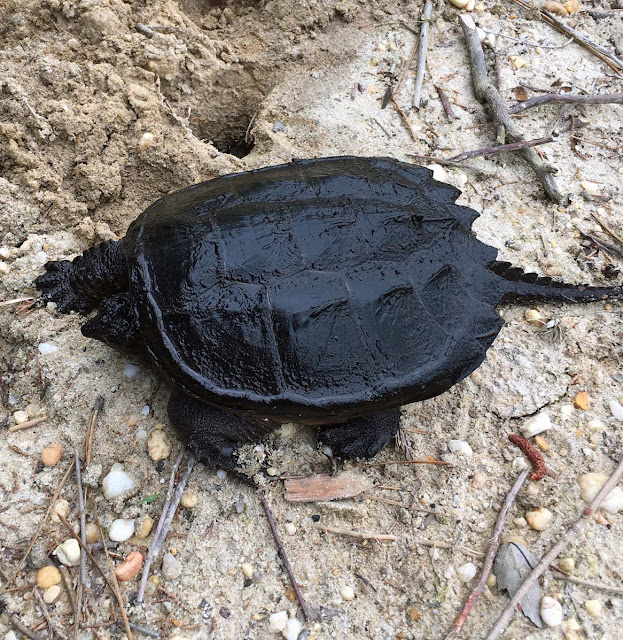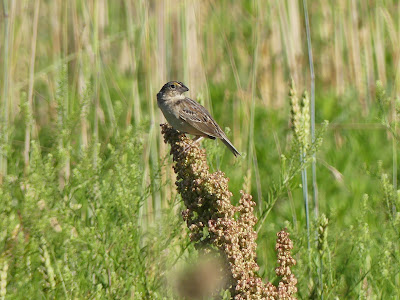I've been doing a lot of "off-chance" birding of late. On the off chance that I might find a Least Bittern I've been searching certain parts of Whitesbog and Reeves Bog where my informant has heard and seen them. I haven't. On the off chance that I might find a Roseate Tern, or one of the two shearwater species that have been reported numerous times, last week I walked the beach at Island Beach SP and stood on the jetty for two hours at Barnegat Light SP. No chance.
But today, on the off chance that my luck would change, I returned to Barnegat Light and again walked out on the jetty as far as I felt safe. I saw another birder all the way at the end by the tower, but my first slight slip stopped where I was. There have been reports of big feeding flocks of gulls & terns around the fishing boats, but the flocks I've seen haven't exactly been swarms and today was no different. Lots of terns diving, Laughing Gulls and Herring Gulls flying overhead, but nothing resembling a shearwater. Not that I'm any kind of authority on shearwaters. I've seen one in Cape May, and thousands one day in Australia and that's the extent of my experience of shearwaters--if someone hadn't been with me to tell me what they were, I'd have never known.
So, I was feeling pretty frustrated and bored before too long today standing on the rocks, looking at gulls that looked very much like the little stick figures we used to draw in school to indicate birds over the sea. Instead of watching birds, I decided to watch the birder. When he picked up his camera, I got interested and following along with where he was aiming I saw one bird that definitely wasn't a gull or tern. Dark, long, straight wings, flying low over the water. I had in my binoculars but dropped it when I tried to find it in the scope. I had the feeling...
The birder soon after turned around and I waited for him to reach me. He turned out to be a birder I know from North Jersey and when I inquired as to his success vis a vis shearwaters he confirmed that he'd been looking at one and showed me the picture he took on the preview screen of his camera. We discussed its flight pattern and he agreed that it went flying back toward where I'd seen my mystery bird. That was enough for me and that's how I got my shitty shearwater sighting for Ocean County. Great Shearwater, which wasn't a life bird. I was hoping for a Cory's Shearwater, which would have been a lifer. For every 4 or 5 Great Shearwaters that have been reported, there has been one Cory's. It is unusual to see so many shearwaters shore for so long, but apparently the fish have moved closer in and the birds go where the food is.
I don't much like Barnegat Light in the summer--to much traffic to get on and off the island, too many people. I was figuring I wouldn't have to go there this summer since I'd seen a Piping Plover at Island Beach and usually I make one trip in the hot weather to get that species.
Which were abundant today. I saw 6 of them and enjoyed seeing the adults and chicks running and stopping, running and stopping, going from the sandy area to the mud flats near the jetty much more than I did looking at distant sea birds.
 |
Piping Plover Chicks
|
So, unless someone can guarantee me a life bird, I'm done for the summer going to Barnegat Light. I much more enjoy the solitude of the bogs to the slog through the sands of the shore.
24 species
Mallard 11
Surf Scoter 1 Drake off 8th st jetty
Mourning Dove 1
American Oystercatcher 7
Piping Plover 6 Banded birds
Laughing Gull 100
Herring Gull 50
Great Black-backed Gull 25
Common Tern 50
Forster's Tern 2
Great Shearwater 1 Larger than LAGU, long straight wings, flying low over water
Double-crested Cormorant 7
Great Egret 1
Glossy Ibis 3
Osprey 4 One carrying a huge whitefish
American Crow 5
Tree Swallow 1
Barn Swallow 4
Gray Catbird 1
House Sparrow 1
House Finch 1
Song Sparrow 2
Red-winged Blackbird 2
Northern Cardinal 1 Heard





















